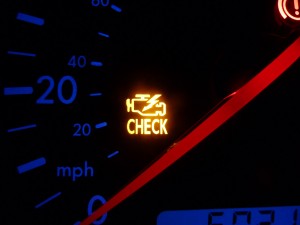Your transmission is the hardest working component in your vehicle; therefore it will take the brunt of wear and tear due to the heat and friction produced with by the vehicle’s moving parts. The following is a list of the most common transmission problems that drivers face. If you experience or are experiencing any of the following symptoms with your vehicle and live in the Virginia area, it’s recommended that you schedule an appointment or visit Cavalier Mazda of Chesapeake, VA today.
Your ‘check engine light’ is the first indication to any problems that may require your attention concerning your vehicle. The check engine light does not illuminate just because there is a transmission issue, but if the light is on and you experience any of the following signs of transmission failure, you will want to consult your mechanic as soon as you can to prevent further damage occurring.
A burning smell in your vehicle is a signal that there is something wrong with your car and will require attention immediately. A burning smell can be produced from your transmission. This is caused by low fluid levels or fluids that have been broken down by the heat and friction produced by operation.
Leaking fluid is the number one reason of transmission failure. Transmission fluid is designed to stay within the transmission to cool down and lubricate operations. There is no place for the fluid to go. If fluid levels are dropping, it may be due to a leak. Place cardboard underneath your transmission to test for leaking. Transmission fluid is red in color or a dark red/brown color with a sweet smell. If transmission fluid is collecting on the piece of cardboard, you have a leak and will require attention immediately.
Low fluid levels will lead to many, and often expensive, issues within your transmission. Low fluid levels could lead to many symptoms including the burning of fluid and slippage of gears. A sufficient level of transmission fluid is required to maintain lubrication, cooling, operations and necessary pressure.
Lack of response is another transmission issue to look out for. When shifting your vehicle into drive from park, the gears should respond immediately. If you notice a delay (typically 1.5 – 2 seconds) before your vehicle moves, your transmission is showing signs of response troubles.
Like lack of response, drivers with transmission problems also experience the inability to change gears. This is an issue especially found in automatic transmissions, where gears refuse to shift while in operation. Those that drive manual transmission vehicles will also notice the difficulty in shifting.
Some transmission issues allow for the ease of gear shifting but will pose troubles in staying in gear. This is the problem of gear slipping. While on the open road, it’s common for a bad transmission to drop out of gear. This is evident through changes in engine noise/pitch as the gears slip into a lower gear, awaiting sufficient pressure to shift back into the correct gear.
Another problem with open road transmission problems is a grinding and/or shaking feeling. Your vehicle is designed for a smooth ride with effortless transitions from gear to gear. A manual transmission that is experiencing troubles will present a grinding feel and sound when shifting. An automatic transmission problem will give the sensation of shaking or wobbling as the gears shift.
A defect in your transmission could start out as a small problem but could easily become a huge problem, requiring replacement that will present you with a very large bill. If you experience any of the symptoms above, contact your mechanic as soon as possible to prevent a small problem from becoming a large one.
Cavalier Mazda specializes in transmission services and our team would be happy to assist you. Conveniently schedule an appointment online now or view our service department menu.





